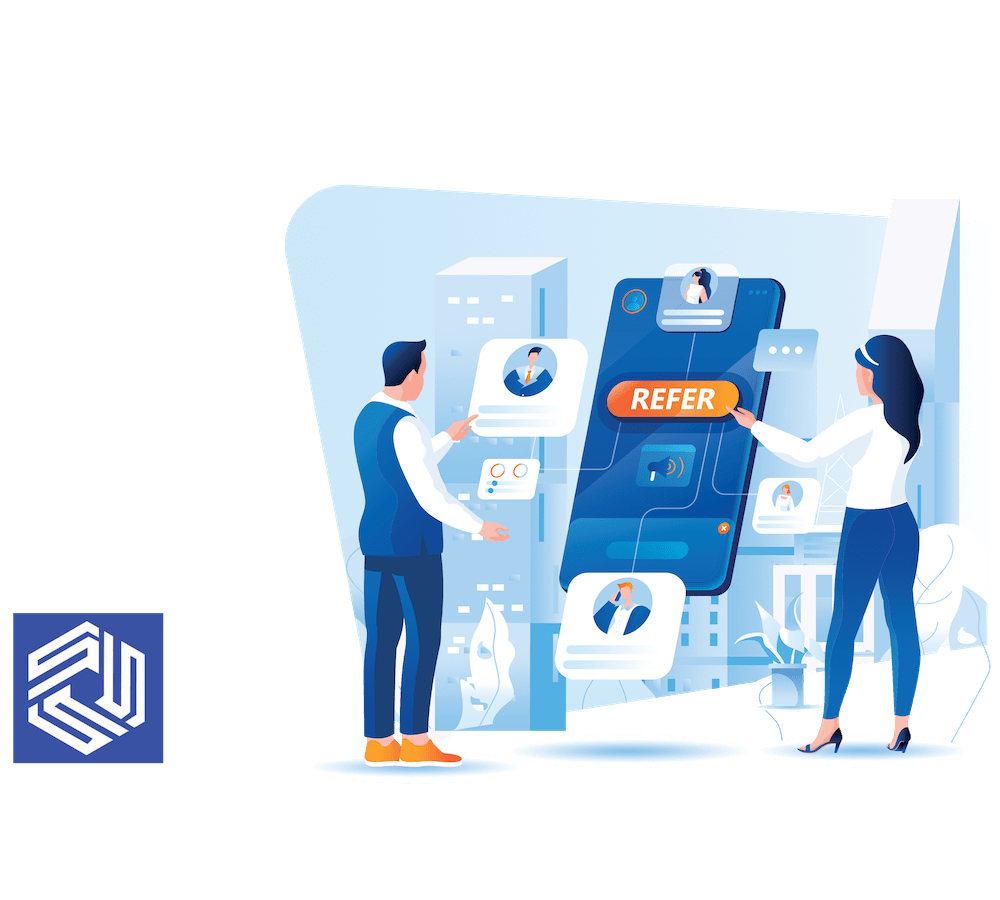The Impact of Referral Programs on Customer Acquisition and Retention
A referral program is a marketing strategy used by businesses to encourage existing loyal customers to refer new customers. This is typically done by offering referral rewards or customer loyalty points, such as a discount or cash bonus, to customers who refer a friend. These programs can be implemented in various ways, such as through a referral link, a referral code, or a referral form on a company website. They can also be integrated with different channels, such as email, social media, and mobile apps. The goal of referral is to generate new leads and customers through word-of-mouth marketing, while also rewarding and encouraging happy customers.

Purpose Of The Blog Post
The purpose of the blog post is to explore the impact of referral programs on customer acquisition & retention. The post will provide an in-depth analysis of how these programs drive new acquisition, and how they can help retain existing customers. The post will also provide examples of businesses that have seen success with referral-based customer acquisition and retention.
In this article, we will discuss the best practices for implementing a referral program that aligns with your business's products or services and target audience, and that generates new leads and customers through word-of-mouth marketing. We will also explore strategies for promoting and maintaining a referral program, and for measuring its success, so you can make adjustments as necessary to improve its effectiveness. If you're interested in leveraging the power of referral marketing, read on to learn more about the best practices for implementing a successful referral program.
Additionally, the post will discuss the potential limitations of referrals and provide best practices for implementing an effective referral program.
Brief overview Of The Impact Of Referral Programs
Important factor: Referral programs can have a significant impact on customer acquisition and retention. They drive acquisition by encouraging existing customer base to refer new business, which generates new leads and customers through word-of-mouth marketing. These programs can also help to retain current customers by giving them a sense of ownership and engagement in the business, as well as an incentive to continue doing business with the company.
Additionally, they can also provide valuable insights into customer behavior and preferences, allowing businesses to better target and engage with their audience. In terms of limitations, referrals may not be effective for all types of businesses or customers, and the referral process itself might not always be smooth or easy for all the customer. However, with proper planning and execution, referrals can be a powerful tool for driving acquisition and retention.
The Impact of Referral Programs on Customer Acquisition
Word-of-mouth marketing is one of the most powerful forms of marketing, as it is based on trust and personal recommendations. When a current customer refers a friend or family member to a business, it carries more weight than a traditional advertisement or marketing campaign.
A good referral program can also help to generate new leads and customers by leveraging the power of social networks. For example, if a customer shares a referral link on social media, it can be seen by their entire existing network of friends and followers, increasing the potential reach of the referral program.
To maximize the impact of referral programs on acquisition, it's important to carefully design the program to align with the type of products or services the business offers, and to target and engage with the right audience.

How referral programs drive new customer acquisition
The incentives can be in the form of cash bonuses, discounts, free products or services, or other rewards. When existing customers are given an opportunity to be more like brand advocates, they are more likely to actively promote the business to their network of friends, family members, and colleagues that could also do a future purchase.
When new users or customers acquired are referred by an active customer, it carries more weight than a traditional advertisement or marketing campaign. The referral comes from a trusted source, the existing customer, and the new customer is more likely to trust the business and make a purchase.
Additionally, referral programs can also leverage the power of social networks to generate new leads and potential customers. For example, if a customer shares a referral link on social media, it can be seen by their entire network of friends and followers, increasing the potential reach of the referral program. Additionally, many referral programs now offer rewards for successful referrals, providing added incentives for customers to promote the business to their networks.
Examples of Businesses that Have Seen Success with Referral-Based Customer Acquisition
There are many businesses that have seen success with referral-based customer acquisition. Here are a few examples:
#1. Skhokho:
Skhokho's affiliate marketing program is one of the very few affiliate programs that will pay you for as long as your clients remain on our platform. Referrals that you send to Skhokho will get a 10% discount off their monthly subscription for up to 10 employees. What's even more better is that you don't have to be a subscriber on the actual Skhokho Business Management Software, just create your affiliate marketing account and log in to your personalised dashboard to track in real-time the current status of: (1) number of people who have clicked on your link, (2) how many people have created a free-trial and (3) How many active accounts created with your link (net promoter score).

For more information on Skhokho affiliate program, click here. Also click here for a documentation guide on how to use the software.
#2. Dropbox
Dropbox, a file hosting service, offered existing customers extra storage space for every new user they referred to the platform. This referral program helped the company to acquire millions of users in a short period of time.
#3. Airbnb
Airbnb's referral program offers both the referrer and the referred a credit towards a future stay. This referral program helped the company to acquire new customers and expand its reach globally.
#4. PayPal
PayPal's referral program offered existing customers $20 for every new user they referred to the platform. This helped the company to acquire millions of new customers and become one of the leading online payment systems.
#5. Churnbuster
Churnbuster, a subscription-based service, offers a referral program that rewards customers with a month of free service for every new customer they refer. This referral program helped the company to acquire new customers and reduce customer churn.
These are just a few examples of how referral programs have been used to drive new business. These businesses have been able to acquire new customers at faster conversion rates and at a lower cost than traditional marketing methods, and have seen a significant return on investment from their referral programs.
Potential limitations of referral programs for customer acquisition
While referral marketing programs can be an effective way to drive customer acquisition, they do have some potential limitations. Here are a few:
- Limited reach: Referral programs rely on the networks of existing customers, which can be limited in size. This means that referral programs may not be as effective for businesses that are looking to acquire a large number of new customers quickly.
- Difficulty in tracking: Measuring the success of a referral program can be difficult, as it can be hard to track the origin of new customers. This can make it difficult to determine the ROI of a referral program and to make adjustments to improve its effectiveness.
- Dependence on existing customers: Referral programs rely on the participation and engagement of existing customers. If existing customers are not motivated to participate in the referral program, it may not be as effective.
- Not suitable for all types of businesses: Referral programs may not be suitable for all types of businesses or products. For example, businesses that sell high-end luxury products may not see as much success with a referral program as a business that sells more affordable, everyday products.
- Potential legal issues: Referral programs may have legal requirements depending on the location and the type of referral program. For example, some referral programs may be considered pyramid schemes, which are illegal in some jurisdictions.
In order to overcome these limitations, businesses should carefully design and execute their referral programs to align with the type of products or services they offer, and target and engage with the right audience. Additionally, businesses should put in place tracking and measurement systems to monitor the success of the referral program, and make adjustments as necessary.
Best Practices for Implementing a Referral Program
Referral programs can be a powerful tool for driving customer acquisition and retention, but it's important to design, execute, and measure them properly to achieve the desired results.

Tips for designing an effective referral program
Here are a few tips for designing an effective and successful referral program:
- Make it simple: The referral process should be as simple as possible. This means that the referral form or link should be easy to find, and the process of referring a friend or family member should be straightforward.
- Offer a clear incentive: The incentive for referring new customers should be clear and attractive. This could be a cash bonus, a discount, or a free product or service.
- Communicate the program clearly: Make sure existing customers are aware of the referral program and understand the process and incentives. This can be done through email, social media, or in-person communication.
- Measure success: It's important to track the success of the referral program and measure the return on investment. This will allow you to make adjustments to improve the program over time.
- Reward both parties: Consider rewarding both the referrer and the referred. This will motivate both parties to participate in the referral program and will increase the chances of success.
- Tailor the program to your audience: Make sure the referral marketing program aligns with the type of products or services your business offers and target the right audience.
- Make it exclusive: Make the referral program exclusive and time-limited, this will create a sense of urgency and exclusivity that will motivate customers to participate and refer their friends.
- Make it easy to share: Make it easy for customers to share the referral link or code with their friends and family. This can be done through email, social media, or messaging apps.
By following these tips, businesses can design a referral marketing program that is effective, engaging, and drives customer acquisition and retention.
Strategies for promoting and maintaining a referral program
Here are a few strategies for promoting and maintaining a referral program:
- Make it visible: Make sure the referral program is visible on the business's website and social media platforms. This can be done through banners, pop-ups, or dedicated landing pages.
- Communicate the program to existing customers: Send an email or a message to existing customers, explaining the referral program, the process and the incentives.
- Use social media: Use social media platforms to promote the referral program and make it easy for customers to share the referral link or code with their friends and family.
- Use Influencers: Partner with influencers in your industry or niche, this will help you to reach a broader audience and promote the referral program in a more organic way.
- Use referral marketing software: Use referral marketing software to automate and track the referral process, this will make it easier to manage and measure the success of the referral program.
- Reward program champions: Identify and reward customers who are actively participating in the referral program, this will help to maintain their engagement and motivation.
- Continuously monitor and improve: Continuously monitor and analyze the referral program's performance, and make adjustments as necessary to improve its effectiveness.
- Make it fun and creative: Make the referral program fun and creative, this will make it more engaging and will increase the chances of success.
By following these strategies, businesses can effectively promote and maintain their referral program, and drive customer acquisition and retention.
Recommendations for measuring the success of a referral program
Measuring the success of a referral program is crucial to determine its effectiveness and make adjustments to improve it over time. Here are a few recommendations for measuring the success of a referral program:
Track referral conversions: Track the number of referred customers who make a purchase or sign up for a service. This will give you an idea of the referral program's effectiveness in driving customer acquisition.
Monitor referral traffic: Monitor the referral traffic to your website, this will give you an idea of the referral program's reach and impact.
Measure customer retention: Measure the retention rate of referred customers, this will give you an idea of the referral program's impact on customer retention.
Track referral source: Track the source of the referral, whether it's a social media share, an email referral, or a referral link. This will help you understand which channels are driving the most referrals work.
Use referral marketing software: Use referral marketing software to automate and track the referral process, this will make it easier to manage and measure the success of the referral program.
Track referral ROI: Track the return on investment of the referral program by comparing the cost of the incentives against how much revenue generated by referred customers and which customers repeat purchases.
Use A/B testing: Test different referral program incentives, messages, and designs, this will help you understand what works best and make adjustments accordingly.
Monitor engagement: Monitor the engagement levels of the referred customers, this will give you an idea of how well the referral program is working in terms of customer retention.
By following these recommendations, businesses can effectively measure the success of their referral program and make adjustments to improve it over time.

Final thoughts and recommendations
In conclusion, referral programs can be an effective way to drive customer acquisition and retention. However, it's important to keep in mind that referral programs may not be effective for all types of businesses or customers, and that it's important to tailor the program to align with the type of products or services the business offers, and to target and engage with the right audience. Additionally, businesses should continuously monitor and analyze the referral program's performance, and make adjustments as necessary to improve its effectiveness.
In summary, referral programs can be a powerful tool for driving customer acquisition and retention, but it's important to design, execute and measure them properly to achieve the desired results.
Call to action
If you're interested in driving customer acquisition and retention through referral programs, now is the time to take action. By implementing an effective referral program, you can tap into the power of word-of-mouth marketing and leverage the networks of your existing customers to generate new leads and customers.
Don't wait any longer, referral programs can be a powerful tool for driving customer acquisition and retention, and can be a great addition to any business's marketing strategy. So, start planning and implementing your referral program today!
Additional Resources
Here are a few links to relevant tools and software that can help businesses implement and manage referral programs:
- ReferralCandy
- Ambassador
- Post Affiliate Pro
- Referral Rock
- Referral Hero
- Referral SaaSquatch
- Referral Factory
- Referral.io
- Referral Bliss
- ReferralCrowd
These tools and software can help businesses automate the referral process, track and measure the success of referral programs, and provide insights into customer behavior and preferences. They can also help businesses design, promote and maintain an effective referral program. It's worth trying out a few of them to see which one will fit best for your business needs and goals.









